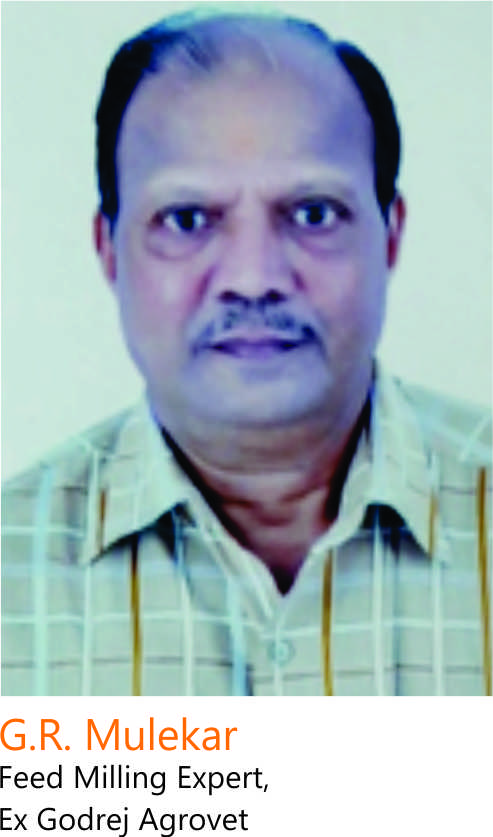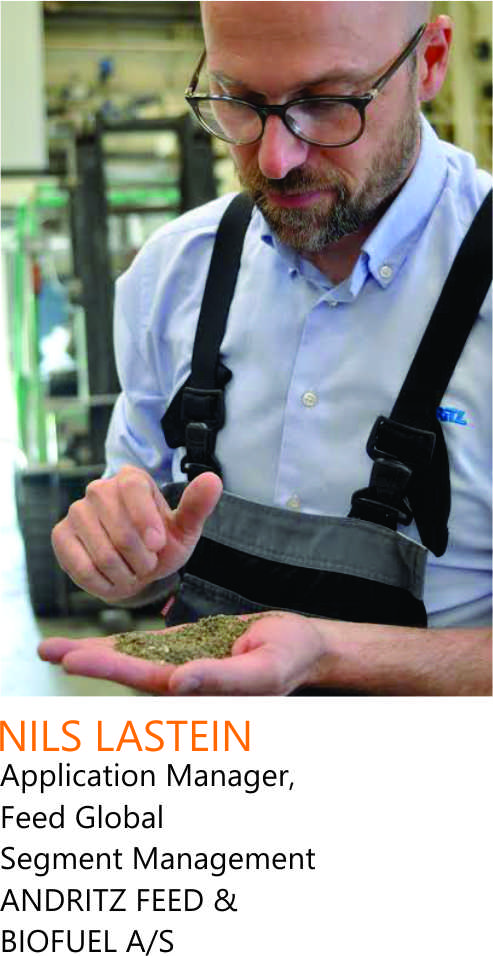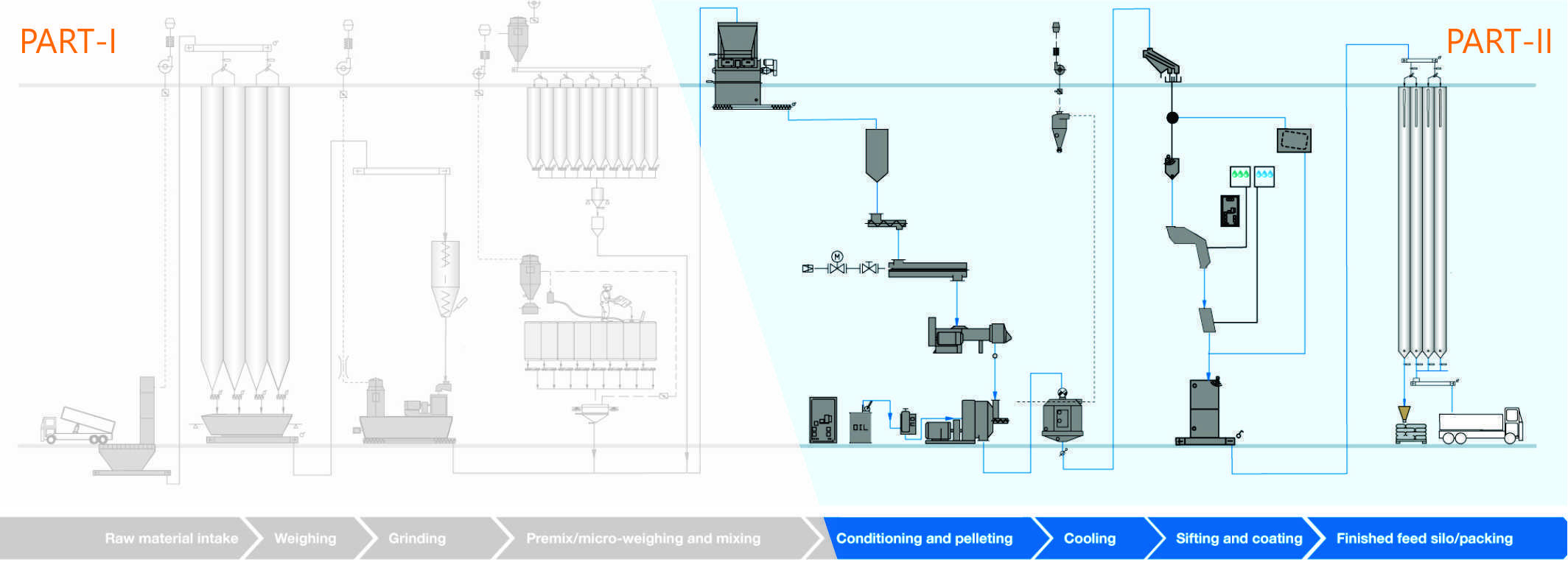

Renowned experts including Dr Manju Reddy (MR), Asst. Vice President with Japfa India; Mr GR Mulekar(GRM), freelance consultant and Mr Nils Lastein(NL), Application Manager, Andritz Feed & Biofuel A/S joined the webinar as speakers. The 90-minute session was attended by 279 attendees from 24 countries. Below excerpts from the discussion.
In the conditioning process, starch gelatinization is one of the major factors. How does it influence the animal performance as well as the feed quality and pellet machine productivity?
MR: Starch gelatinization is the skeleton producing good quality of feed, a feed mill usually

Starch gelatinization increases the energy level of the ingredients. Few experiments show that if maize is treated at 80-85°C at proper conditioning level, then there is an energy increase that helps the birds in contributing nutrients. In conditioning or gelatinizing, there is also plasticizing of individual particles i.e., feed particles will get together which help in binding. And there is a creation of liquid bridges between the particles which are formed during processing which results in gelatinization, causing the lubricating effect to the product. So, it will help the feed to get pelletized easily and will reduce electricity consumption, improve your throughput and more than anything it will help in formation of good quality pellets.
Better the gelatinization process is, the lower the fine percentage will be. Other advantages are destruction of anti -nutritional factors and increasing solubility of NSPs (Non-Starch Polysaccharides). There is disadvantage if pellets are treated with conditioning temperature and moisture, some problems might be created for wheat and barley diets. As it will cause increased solubility of some of the non-starch polysaccharides causing some gut health issues. Apart from that, some of the phytates, an antinutritional factor, also gets destroyed whenever it is properly gelatinized and processed.
As in the feed milling process, starch will be damaged due to the grinding process as well as in the pellet die, whereas conditioning only will have the actual gelatinization. How to identify the percentage of starch gelatinization happening only because of the conditioning?


Managing targeted moisture with new crops which usually have higher moisture or stored grains which usually have lower moisture, is a challenge for feed miller. What would be your suggestions?
NL: The main problem for temperature or moisture regulation is moisture addition at the set temperature. Steam is added which brings the moisture but it is not added with the moisture set point rather added to the temperature set point. Feed producers have problems obtaining the right moisture content when the initial moisture content of the grain is too high and adding moisture by temperature brings an evident problem right there itself.
The low moisture is more or less easily handled. It can be adjusted by water spray at a

But when water is added by spraying nozzles, we have droplets which will take a long time to migrate into the particles and even then, proper absorption is not achieved resulting in multiple problems. When water droplet is added into the feed it does not evaporate as easily as the water added by steam, it will remain as a moist spot in the feed resulting in rotting and the bacteria growth due to increased water activity. That is why water is often applied together with a surfactant that will reduce bacterial growth.
In the wet situation while using a fresh harvest, moisture control is more difficult. Due to the cost involved, grain drying is avoided. One of the quite easy methods is actually to have a die with a shorter compression ratio, a shorter compression channel and a lower L/D ratio.
Formulations keep on changing as per the market conditions which influence both target moisture and temperature. What are your suggestions to optimize?
GRM: The formulation changes frequently almost every month because of the raw material price and availability, and the weather conditions. Generally, in the winter season, bird growth rate is very high and the market price for the ready bird is also good which usually is not the case in summer season. The feed miller should have at least 2-3 types of dies with various designs especially focusing on the compression ratio or L/D ratio. If the L/D ratio is maintained for different formulations then one will get a good pelleting rate in any situation. Selecting the right kind of die for any particular formulation is the key.
What are the factors to optimize throughput, energy consumption, and pellet quality?
MR: Pellet mill output is basically a fine balance between three factors i.e., raw material, process control and the machine. Raw material characters include four parameters i.e., physical parameters that are formulation density, moisture level, particle size and the shape. The finer the particle is, the better the palatability will be. But many times, looking at the gut health, one tends to increase the particle size and end up with more coarser particles resulting in a compromised pellet quality. Apart from that the uniformity of the particle size distribution is also very important, if it is grinded in a 3-4 mm combination sieve and does not have a normal bell curve particle distribution, it will cause problems. A lot of factors influence the chemical properties, basic ones are gelatinization, starch content, crude protein content, fat content, fiber content and ash content. The ash content is also very important, in the normal broiler feed processing ash content is about 5-6% but when it is breeder feed processing you will never get output like in broiler feeds. The major difference causing this problem is ash content.
Under process control, steam quality is most important. Multiple controls in steam especially the pressure at the inlet of the injection point is very important and the throughput regulation. Many times, in rush the pellet quality is compromised. If it is not properly gelatinized, it will have a lot of fine returns screwing up the pelleting process. Also, for liquid addition, in India, traditionally feed miller goes for addition of 4-5% of fat without any calculation while in present scenario when the price of oil is so high, one cannot add 2-2.5% oil. Excess fine returns, excess fat or throughput not regulated properly need to be controlled.
The machine typically involves die, roller, and cooling and drying, and feed rate. Die hole, configuration and die diameter are important factors. Roller adjustment is a skill especially when it is related to moisture percentage. In drying and cooling, if it is not properly cooled and moisture is not taken out, it will affect the pellet quality. The whole cycle, starting from formulation to bagging, needs to be controlled to have optimum pellet mill output. It needs proper synchronization between the control panel team and the operators.


LS: Roll adjustment is a fine art but generally the operators do not want to have interruptions. They prefer to push the rollers out into zero position or even in a minus position which squeezes tight against the inside die surface. What a feed miller need is really close but not touching position of the rollers which is an ideal situation.
Considering process variations or formulations with low, medium or high fat, an instant change of the die configuration on a daily or hourly basis is the simple solution. A feed miller has two or three dies lying next to the press and using a Quick Die Changing (QDC) system the die can be replaced within 10-15 minutes.
Automatic roller adjustment is a technically advanced solution. This system can introduce a gap entry in between die and roller variable from zero to 5-6 mm. It is basically bringing up the press to normal capacity then a gap is introduced in between the roller and the die while looking carefully at press amperage. If there is instability in the press amperage while the roller is retracted from the die that is a signal that all rollers are not continuously gripping into the die rather are slipping, normally, it is the left-hand side leading roller.
When a gap in between the roller and die is introduced, the kneading time is also increased which will consume more power but that power goes into the feed which cools off the die and makes pellets with higher durability and quality. This means a die is installed to suit easy formulations and when it is more complicated formulations which require higher L/D and longer compression then the rollers can be retarcted by giving more power.
What are the critical factors of cooling to achieve the standard moisture as well as the temperature?
MR: The vertical cooler or counter flow cooler is mostly used. Cooling is the most critical factor to determine the end-product quality at bagging, basically the moisture control or water activity (AW). The functioning of a cooler depends upon different critical factors.
First is input and output, the input in the cooler is hot and high moist pellets, and the expected output is low temperature pellet (~4-5°C lower temperature) with reduced moisture of around 11.5-12% (as per Indian conditions) at the time of bagging. Both objectives can be achieved by using the counter flow of the air to cool the pellets and the amount of temperature loss in the cooler is basically defined by the quality of air used to absorb the cooler.
Another factor is the temperature of the cooling air whether it is cool or warm and humidity percentage of the cooling air. The water capacity of high humid air is very less, normally in such conditions, the cooler turns inefficient to reduce the moisture. There are options like increasing the speed of air or installing fans with VFPs (Variable Frequency Drives) which remove the moisture more accurately. Unfortunately, in a high humid climate, the moisture is not reduced and the end products have high moisture and temperature. This leads to fungus growth in the feed.
With cool air, there is a different issue of condensed water. When the cool air gets in and absorbs moisture it results in low atmospheric temperature and hence water condensation is observed. This is observed especially in North India and Eastern part of the country, in winter (when temperature goes as low as 10-15°C), water condensation takes place in the cooler and spoils the entire product.
The air flow rate or the volume of air should also be calculated and it should be normal. In India with four different seasons, cooling is very dynamic.
While setting up the rolls, which is a conventional setting done by an operator, can we measure if the gap is the optimum gap by measuring the temperature increase at the dies?
NL: There is not any exact set point, it is the power or the temperature increase. A functioning consequence of the amperage that is put into the entrance in the pellet mill, which means more the power consumption higher the temperature of the feed. Higher temperature can be a problem for enzymes like phytase which will deactivate that means you need to compensate with either pre- or post-pellet supplement.
Do you suggest any changes with respect to the residence time of the conditioner based on the formulation?
GRM: In pelleting, on a scale of 100, grinding is 33% then conditioning is 33% followed by 25% in die selection and remaining 9% is cooling. So, the conditioning process is very important. Earlier the pellet mill manufacturers were using single barrel conditioners but with better awareness on conditioning or retention time, they started using two or even three conditioners.
Whether it is a single or multi barrel conditioner, the most important factor is the retention time of the material in the conditioner. For that the operator gives constant speed to the conditioner drive shaft and each shaft at a specific speed delivers the material from one barrel to the second barrel and hence forward. To achieve this constant speed, the machine manufacturer gives a VFD drive (variable frequency drive) to the conditioner. A feed miller should assure a minimum conditioning time of 40-45 seconds right from the feeder to the conditioner till the end of the last conditioner where it enters the pellet mill. Another important point to consider is that the more the fine material is lesser is the conditioning time, say 40 seconds.
Also, one should check the quality of grinding. A simple testing method is to take 200 gm of material and put it on 1 mm lab test sieve then sieve it for 15-20 times and the material which has passed through the sieve should be minimum 80% then it is fine grinding. That means the retention on the 1 mm will be 20%. If it is lesser, then a standard 3 mm sieve is used for the grinder or if possible, it can be 2.8 mm. The grinder sieve can be finer but that will take more time for grinding and the pellet mill will starve for material, so some solution needs to be found out and conditioning is very important.
Another important factor is to have saturated steam. I have observed usage of high-pressure boilers in various feed mills. My suggestion is to use a saturated steam boiler with a pressure of 10.54 kg/cm2. Above this would deliver superheated steam and if the pressure is lesser around 8-9 kg/cm2 then it will deliver wet steam.
NL: At Andritz we try to achieve a retention time of 30-40 seconds. From a technology point of view, it is not recommended to adjust the speed of the shaft because then it does not lift the material into the air compared to the quantity it lifts at normal speed which leaves most of the meal lying down in the conditioner. If the retention time is to be increased then some of the paddles are flipped from forward position to backward position to retain the meal and remain at nominal speed. It is really important that the meal is flying up over the shaft in the conditioner all the way around otherwise the steam cannot get to the particles.
What is the best L/D ratio for cattle feed?
GRM: Nowadays, cattle feed pellets are around 4 mm as maize is added in the formulation. But the formulation of cattle feed is such that it is high in fiber and sand silica and hence the L/D ratio is quite different from poultry feed. It should be around 8-10%, not more than that. Also, one has to go as per the fiber in the formulation if it is very high in the formulation then also the L/D ratio will change.
What is your opinion about the online moisture control for the entire plant?
NL: The technology provides a lot of benefits like moisture adjustment, moisture measurement or protein measurement. Most of the feed millers are using it for online moisture measurement to ensure the least cost optimization. The moisture online NIR is best placed before the pellet mill and it should be installed on the main mixer. Of course, it can do raw material moisture check. In the process line, one can install online measurement on the side of the batch mixer which then can adjust the moisture as per set point. NIR cannot be easily placed at the pellet mill because the technology is based on light reflection, as the moisture sets inside the core of the pellet and light will not reach there and therefore one will get a biased result. So, if one wants to install NIR at a pellet mill, one needs to crush the pellets.NIR is not a plug and play system rather a costly instrument that holds tremendous potential.
MR: The application of online moisture NIR control is very important in the mixer because adjusting the water level for dry conditions causes a lot of problems especially in the Indian context and results in issues with feed consumption. While using NIR, the positioning of sensors in different parts of the mixer and at same time 8-10 reading can be taken. The thumb rule is for every 0.07-0.08% moisture increase an adjustment of 10°C in temperature is required in the conditioning. Using multiple moisture measuring sensors in the mixer one can decide the quantity of water to be added and temperature to be set especially for dry conditions.
Audience Questions:
What is the practical role of pellet binder in commercial poultry feed as feed would be on hold for more than 15-20 days?
It improves binding capacity and pellet remain durable for longer time which results in minimum fines % even after long period storage and handling.
How to correct the formulated feed nutrient content and finished feed nutrient content, if there is difference?
First you decide CV for different nutrient value and same is to be compared with finished feed nutrient and if values are within CV range, material should allow for dispatch or make a decision reprocess the feed.
How much compression and LD ratio required?
L D ratio interprets compression length.
L stands for length through which material is compressed.
D is the diameter of pellets being produced.
L D ratio is different for poultry feed pellets & different for cattle feed pellets.
In poultry feed pellets ratio should be between 10 to 12.
In cattle feed pellets ratio should be between 8 to 10.
Conclusions:
The webinar series discussed the scope of optimizing the feed milling process. It aimed at improving quality or efficiency without disturbing the milling specification any of the process. Every feed miller wishes to achieve these parameters by using the technology. Below are the take home message from the webinar:
- The standard starch gelatinization is 60-70% while the actual starch gelatinization happening in feed milling is less than 30%.
- Feed microscopy is the best method to test starch gelatinization.
- For improved quality and productivity, a feed miller should look into the three factors – raw material, process control and fine returns.
- For dies and rolls, automatic roll adjustment technology is available.
- For cooling, not only air flow rate or retention time is important but ambient condition is most important.
- Grinding plays a vital role for smooth conditioning, pelleting and cooling.













